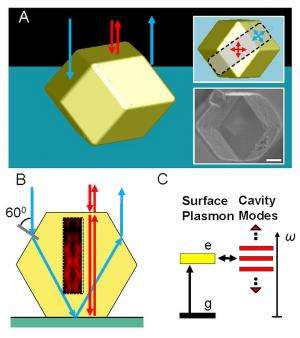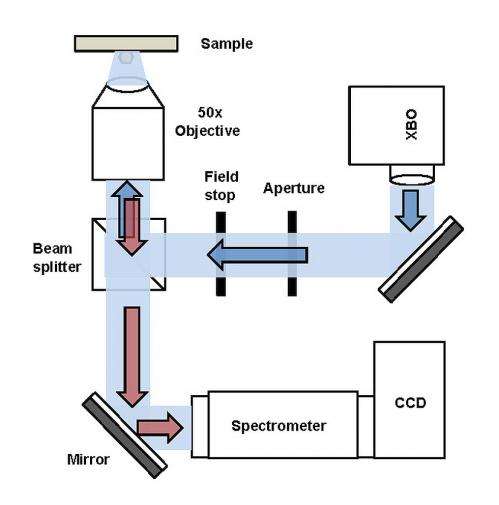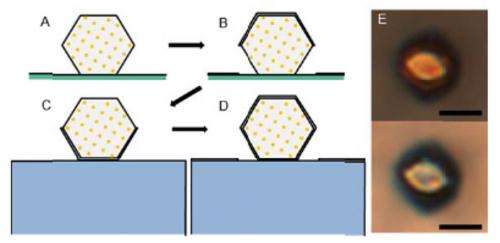A polaritonic photonic crystal made by DNA-programmable assembly. (A) Three-dimensional illustration of a plasmonic PPC, in the shape of a rhombic dodecahedron, assembled from DNA-modified gold nanoparticles. Red arrows indicate light rays normal to the underlying substrate, impinging on and backscattering through a top facet of the crystal (FPMs). The blue ones represent light rays entering through the slanted side facets and leaving the PPC through the opposite side, not contributing to the FPMs (Fig. S2). The top right inset shows the top view of the crystal with two sets of arrows defining two polarization bases at the top and side facets. The bottom right inset shows an SEM image of a representative single crystal corresponding to the orientation of the top right inset. (Scale bar, 1 μm.) (B) A 2D scheme showing the geometric optics approximation of backscattering consistent with the explanation in A. The hexagon outline is a vertical cross-section through the gray area in the top right inset of A parallel to its long edge. The box enclosed by a dashed line depicts the interaction between localized surface plasmons and photonic modes (red arrows; FPMs) with a typical near-field profile around gold nanoparticles. The contribution of backscattering through the side facets (blue arrows) to FPMs is negligible. (C) Scheme of plasmon polariton formation. The localized surface plasmons (yellow bar) strongly couple to the photonic modes (red bars; FPMs). Credit: Park DJ, et al. (2014) Plasmonic photonic crystals realized through DNA-programmable assembly. Proc Natl Acad Sci USA Published online before print on December 29, 2014.
(Phys.org)—As biotechnology and nanotechnology continue to merge, DNA-programmable methods have emerged as a way to provide unprecedented control over the assembly of nanoparticles into complex structures, including customizable periodic structures known as superlattices that allow fine tuning the interaction between light and highly organized collections of particles. Lattice structures have historically been two-dimensional because fabricating three-dimensional DNA lattices has been too difficult, while three-dimensional dielectric photonic crystals have well-established enhanced light–matter interactions. However, the dearth of synthetic means of creating plasmonic crystals (those that exploit surface plasmons produced from the interaction of light with metal-dielectric materials) based on arrays of nanoparticles has prevented them from being experimentally studied. At the same time, it has been suggested that polaritonic photonic crystals (PPCs) – plasmonic counterparts of photonic crystals – can prohibit light propagation and open a photonic band gap (also known as a polariton gap) by strong coupling between surface plasmons and photonic modes if the crystal is in a deep subwavelength size regime. (Polaritons are quasiparticles resulting from strong coupling of electromagnetic waves with an electric or magnetic dipole-carrying excitation.)
To that end, scientists at Northwestern University recently reported strong light-plasmon interactions within 3D plasmonic photonic crystals that have lattice constants and nanoparticle diameters that can be independently controlled in the deep subwavelength size regime by using a DNA-programmable assembly technique – the first devices prepared by DNA-guided colloidal crystallization. The researchers have shown that they can tune the interaction between light and the collective electronic modes of gold nanoparticles by independently adjusting lattice constants and gold nanoparticle diameters, adding that their results in tuning interactions between light and highly-organized nanoscale collections of particles suggest the possibility of applications that include lasers, quantum electrodynamics and biosensing.
Prof. George C. Schatz discussed the paper that he, Prof. Chad A. Mirkin, lead author Daniel J. Park and their co-authors published in Proceedings of the National Academy of Sciences by first addressing the main challenges the scientists encountered in tuning the interaction between light and the collective electronic modes of gold nanoparticles by independently adjusting lattice constants and gold nanoparticle diameters. "The wavelength associated with photonic resonance modes" – such as the Fabry-Pérot interactions that occur with interferometers of the same name – "is defined by an interference condition that depends on geometry of the microstructure, as well as on the effective index of refraction of the material in the microstructure," Schatz tells Phys.org. "At the same time, the wavelength of plasmon resonances in a gold nanoparticle is determined by collective electron excitation in the particle and depends on the size and shape of the nanoparticle as well as on gold's refraction index." The researchers addressed this by fabricating superlattice materials that allow for independently tuning these two wavelengths, and therefore to study the interactions between the resonance modes. Moreover, he adds, the researchers found a range of superlattice and nanoparticle parameters where the photonic modes could be observed both below and above the plasmon energy – that is, its resonance wavelength – enabling them to observe a band gap that indicates strong coupling between the modes.
A second key aspect of their research was using DNA-guided colloidal crystallization to independently control strong light-plasmon interactions within 3D plasmonic photonic crystals that have lattice constants and nanoparticle diameters, as well as synthesizing plasmonic PPCs (polaritonic photonic crystals) from gold nanoparticles. "Prior to our paper and work published last year1 by our colleagues at Northwestern in Prof. Mirkin's group, the DNA-guided crystallization method had been developed for making superlattice materials with variable gold particle size and lattice spacing," Schatz explains.
Experimental and theoretical backscattering spectra of PPC1–3. (A) SEM image (Top) and optical bright field reflection mode image (Bottom) of PPC1 on a silicon substrate. (Scale bar, 1 μm.) (B) Measured backscattering spectrum (red solid line) of PPC1 from the center red spot in A, Bottom. Calculated backscattering spectra based on two infinite slab models with BCC crystal geometry (blue solid line) and EMT approximation (blue dashed line). FPMs are indicated by markers. (C–F) The same datasets for PPC2 and PPC3 as in A and B. PPC2 and PPC3 are on indium tin oxide (ITO)-coated glass slides. The optical images show bright spots at the center owing to backscattering from the top and bottom facets. Two vertical lines in F indicate spectral positions where FPMs are suppressed. (Scale bars, 1 μm.) Credit: Park DJ, et al. (2014) Plasmonic photonic crystals realized through DNA-programmable assembly. Proc Natl Acad Sci USA Published online before print on December 29, 2014.
"However," he continues, "the materials were polycrystalline, and therefore did not exhibit well-defined photonic modes that can allow for probing the interaction between light and surface plasmons. A key advance was the discovery1 of a method for making superlattice single crystals with a well-defined crystal habit – that is, a rhombic dodecahedral shape – and variable size on the order of a few microns." Nevertheless, it was still unclear that there would be optical modes of high enough quality for Fabry-Pérot resonances to be observed and be tuned across the plasmon resonance. "It took several months to theoretically and experimentally probe and confirm the presence of Fabry-Pérot resonances," Schatz adds.
Schatz and his colleagues addressed these challenges by using measurements of backscattering – the reflection of waves, particles, or signals back to the source direction – to probe Fabry-Pérot modes. "Although backscattering measurements have been used in other contexts, this was the first application of this technology to DNA superlattice crystals, and it wasn't immediately clear to us that Fabry-Pérot resonances could be observed for this crystal habit and choice of material," Schatz notes. However, as detailed in their current paper, the scientists developed a realistic theoretical model of this experiment that predicted the existence of Fabry-Pérot modes and the possibility of observing them via backscattering while doing the experiments. "This stimulated us to do the experiments and persist with this work even though the early results were of poor quality. Furthermore, we used the computational model to guide in optimizing the experiment – including the work in which we coated PPCs with silver."
In their paper, the researchers discussed further photonic studies and possible applications in lasers, cavity quantum electrodynamics, quantum optics, quantum many-body dynamics, biosensing and other areas suggested by tuning nanoscale light-plasmon interactions. "Past work has observed quantum electrodynamics behavior in dielectric optical cavities, including enhanced and suppressed fluorescence from emitters in these cavities. The present experiments suggest that this type of measurement can be extended to cavities where hybrid plasmonic/photonic modes occur." He emphasizes that while quantum electrodynamics phenomena via 2D hybrid plasmonic/photonic modes have already been observed for the last several years, their system opens a unique opportunity to utilize 3D crystal modes that contain plasmonic properties. "As a possible application, since plasmon-enhanced lasers have been observed with 2D lattices, the successful observation of 3D hybrid photonic-plasmonic modes suggests that such lasers can be prepared for 3D lattices."
Another interesting finding is the tunability of DNA interconnects and the corresponding volume fraction of the plasmonic elements. "Tunability of the DNA interconnects provides the ability to change the lattice constant," Schatz explains," and with a certain size of nanoparticle, by varying the lattice constant we can tune the gold volume."
A schematic description of the backscattering signal detection setup. The blue arrows indicate the light incident on the sample and the red arrows the reflected light. Only the reflection mode, not the transmission mode, is reflected. Credit: Park DJ, et al. (2014) Plasmonic photonic crystals realized through DNA-programmable assembly. Proc Natl Acad Sci USA Published online before print on December 29, 2014.
When asked if their findings might interact with or contribute to developments in synthetic biology and synthetic genomics, as well as the accelerating integration of biotechnology and nanotechnology in translational medicine, Schatz pointed out that DNA provides a synthetic 'hook' that can be connected to synthetic biology. "We can therefore envision using the genetic programmability of DNA as input to the synthesis of fluorescent proteins in precise locations," adding that the medical applications of DNA-programmed superlattice materials are only at the concept stage. "From earlier work in the Mirkin group, we know how to use gold nanoparticles coated with DNA in medical diagnostics and therapeutics, so one can imagine future applications where these applications are extended to superlattices. A key point is that the superlattices provide a systematic tool for building structures that combine together inorganic components, such as metal or semiconductor nanoparticles with biomolecules."
Moving forward, Schatz says, the researchers need to generalize the menu of superlattice crystals. "The micron-scale crystal habits exhibit other photonic modes – that is, functionalities – such as whispering gallery resonance and light focusing. In addition, other nanoparticle components such as silver nanoparticles and quantum dots can be incorporated into superlattices." This means that the scientists can play with a large number of photonic/electronic degrees of freedom within the framework of a DNA superlattice. "Therefore, we need to establish a well-defined set of photonic applications and studies utilizing and combining those physical degrees of freedom – and theory will play an important role in this process."
PPC silver coating process. (A) A PPC on a glass slide. (B) A silver layer is deposited on the PPC. (C) The uncoated bottom side of the PPC is exposed after sticking the PPC to the top surface of a PDMS pillar. (D) Another layer of silver is deposited on the uncoated side. (E) The top image shows a PPC at step (C), and the bottom step (D). A 100x objective was used and the scalebar is 2 μm. Credit: Park DJ, et al. (2014) Plasmonic photonic crystals realized through DNA-programmable assembly. Proc Natl Acad Sci USA Published online before print on December 29, 2014.
In terms of additional innovations, Schatz tells Phys.org that "now that we know that plasmon-photonic interactions can exhibit strong coupling, we need to expand this research, probably with different nanoparticles and with different types of photonic resonances. For example, we can incorporate anisotropic nanoparticles that exhibit more interesting plasmonic response to polarization of light – and utilizing other available photonic modes that exhibit light focusing features, we can think about developing optical components such as a plasmonic microlens. Finally, synthesizing quantum dot nanoparticle superlattices, we can perform fundamental physics studies related to the collective exciton emission."
Schatz concludes that other areas of research might also benefit from their study. "We're excited about the possibility of using superlattice materials not just in photonics, but also in energy-related applications, including photovoltaics, photocatalysis, and batteries."
More information: Plasmonic photonic crystals realized through DNA-programmable assembly, Proceedings of the National Academy of Sciences published online before print December 29 2014, doi:10.1073/pnas.1422649112
Related:
1DNA-mediated nanoparticle crystallization into Wulff polyhedral, Nature (2014) 505(7481):73–77, doi:10.1038/nature12739
Journal information: Proceedings of the National Academy of Sciences , Nature
© 2015 Phys.org



























